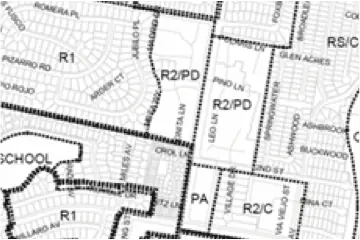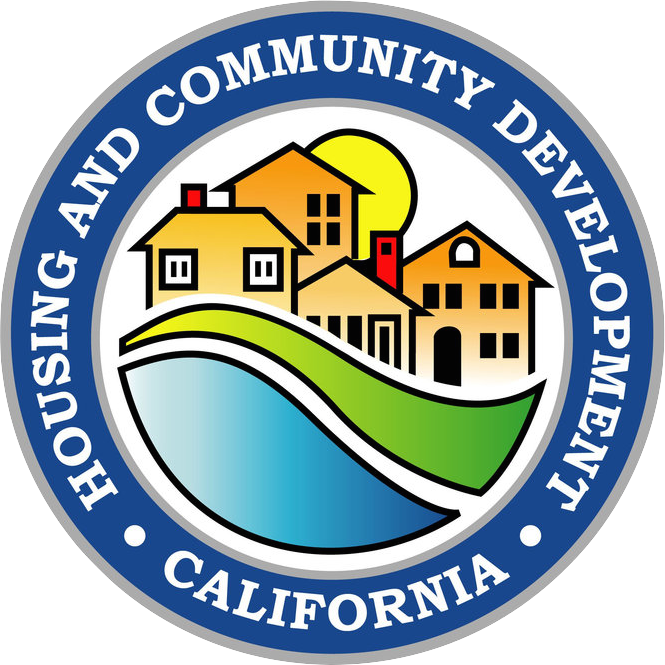Land-Use Controls
Government Code Section 65583(a) requires “An analysis of potential and actual governmental constraints upon the maintenance, improvement, or development of housing for all income levels,…including land use controls, building codes and their enforcement, site improvements, fees and other exactions required of developers, and local processing and permit procedures…”.

Although local ordinances and policies are enacted to protect the health and safety of citizens and further the general welfare, it is useful to periodically reexamine local ordinances and policies to determine whether, under current conditions, they are accomplishing their intended purpose or constituting a barrier to the maintenance, improvement, or development of housing for all income levels.
Such an examination may reveal that certain policies have a disproportionate or negative impact on the development of particular housing types (e.g. multifamily) or on housing developed for low- or moderate-income households.
Ordinances, policies, or practices that have the effect of excluding housing affordable to low- and moderate-income households may also violate state and federal fair housing laws that prohibit any land-use requirements that discriminate (or have the effect of discriminating) against affordable housing.
The analysis of potential governmental constraints should describe past or current efforts to remove governmental constraints. The analysis should identify the specific standards and processes and evaluate their cumulative impact on the supply and affordability of housing. Each analysis should use specific objective data (quantified, where possible).
In cases where the analyses identify existing constraints, the housing element should include program responses to mitigate the effects. A determination should be made for each potential constraint as to whether it poses as an actual constraint.
Requisite Analysis
The housing element must identify all relevant land-use controls, discuss impacts on the cost and supply of housing, and evaluate the cumulative impacts of standards, including whether development standards impede the ability to achieve maximum allowable densities. The analysis must also make a determination as to whether land-use controls constrain the development of multifamily rental housing, factory-built housing, mobilehomes, housing for agricultural employees, supportive housing, single-room occupancy units, emergency shelters, and transitional housing. The types of land-use controls appropriate to analyze will vary from jurisdiction to jurisdiction.
In addition, as appropriate, the program will discuss efforts to remove governmental constraints, especially relating to single-room occupancy units, supportive housing, transitional housing, and emergency shelters.
The following sample tables can be used to organize critical information pertaining to housing element requirements. The information provided in the tables should be tailored to the jurisdiction and followed by an appropriate analysis. (Note: These sample tables are not intended to be a substitute for addressing the analytical requirements described in the statute.)
| DEVELOPMENT STANDARDS | ||||||||||
|---|---|---|---|---|---|---|---|---|---|---|
| Zone District | Bldg Height | Lot Width | Minimum Yard Setback | Minimum Lot Area (sq. ft.) | Lot Area per Dwelling Unit (sq. ft.) | Parking Spaces per Dwelling Unit | Minimum Open Space (sq. ft.) | |||
| Front | Side | Rear | Front | |||||||
In addition to the standards identified in the table above, other development standards to consider and analyze by zoning category are as follows:
- Density.
- Parking requirements (including standards for enclosed or covered and guest spaces).
- Lot coverage.
- Height limits.
- Lot size requirements.
- Unit size requirements.
- Floor area ratios.
- Setbacks.
- Open space requirements.
- Growth controls (including urban growth boundaries and any moratoria and prohibitions against multifamily housing).
Parking
Excessive parking standards that are not reflective of actual parking demand can pose a significant constraint to housing development by increasing development costs and reducing the potential land available for project amenities or additional units. Therefore, the housing element should include an analysis of the jurisdiction’s parking standards by zone. The analysis should examine whether parking standards impede a developer’s ability to achieve maximum densities, and if there are provisions in place to provide parking reductions where less need is demonstrated, particularly for persons with disabilities, the elderly, affordable housing, and infill and transit-oriented development. In addition, the jurisdiction should verify that the density bonus ordinance complies with parking requirements per Government Code Section 65915.
Height Limits
Limitations on height can constrain a development’s ability to achieve maximum densities, especially in culmination with other development controls. Height limits of two stories or less in multifamily districts is one example of development standards that can constrain achieving maximum densities.`
Cumulative Effect of Development Standards
The housing element must also analyze the cumulative effect of development standards on the development of housing and/or achieving densities after considering how all standards and/or ordinances relate to each other. For example, excessive onsite parking requirements in conjunction with small allowable lot coverages could significantly minimize the building envelope for residential projects.
In addition, the analysis must evaluate the cumulative impacts of development standards on the ability to achieve maximum densities.
Density Bonus
State law requires jurisdictions to provide density bonuses and development incentives to all developers who propose to construct affordable housing on a sliding scale, where the amount of density bonus and number of incentives vary according to the amount of affordable housing units provided. Specifically, state law requires the provision of total units to be affordable to lower- and moderate-income households. Under state law, a development of more than five units is eligible to receive density bonuses if it meets at least one of the following:
- Very Low-Income Units: Five percent of the total units of the housing development as target units affordable to very low-income households; or
- Low-Income Units: Ten percent of the total units of the housing development as target units affordable to low-income households; or
- Moderate-Income Units: Ten percent of the total units of a newly constructed condominium project or planned development as target units affordable to moderate-income households, provided all the units are offered for purchase; or
- Senior Units: A senior citizen housing development of 35 units or more.
If no density bonus ordinance is adopted by the jurisdiction, a programmatic action must be included to adopt density bonus provisions.
Growth Control or Similar Ordinances
Ordinances, policies, procedures, or measures imposed by the local government that specifically limit the amount or timing of residential development should be analyzed as potential governmental constraints and mitigated, where necessary. The analysis will vary depending on the nature of the measure. In general, the measure and its implementation procedures must specifically be described and analyzed for their impact on the cost and supply of housing.
For ordinances that control the number and timing of permits, the element must describe any permit allocation process, allocation timing, specific limits on the number of permits issued per project type, any affordable housing incentives in the allocation process, the method of determining the number of permits to be issued annually, and the basis for this determination.
The analysis must also identify and analyze process impacts, such as application procedures and requirements (e.g. design review; limits of number of permits or size of project; length of approval; discretionary approval; and how the ordinance operates with rest of the entitlement process, carryovers, and financing of the project).
The analysis should demonstrate how the policy or ordinance accommodates the locality’s current regional housing needs allocation (RHNA) for all income groups. If it does not, the housing element must include a program to mitigate the impacts of the ordinance and allow accommodation of the total housing need.
Examples of types of policies or requirements that should be analyzed include:
- Systematic (area-wide) residential down-zoning.
- Urban limit line, growth boundaries, or perimeter greenbelt.
- Annexation restrictions.
- Building permit or other residential development caps.
- Voter approval for up-zoning, rezoning or general plan changes.
- Legislative super-majority for up-zoning, rezoning or general plan changes.
- Systematic changes to local height and floor area ratio regulations.
- Adequate public facilities ordinances.
The housing element should not only demonstrate the jurisdiction can accommodate the RHNA at minimum, but must also analyze the impact of the growth management or controls process and procedure on the cost and affordability of housing. Even if the growth control ordinance allows the community to meet its entire RHNA, the ordinance may still be a constraint that requires mitigation because of increased processing costs or timing delays.
The RHNA should not be considered or treated as a ceiling on the development of housing or as a basis for denying housing applications.
Form-Based Codes
Jurisdictions that have adopted form-based codes should clearly describe and analyze the following to ensure that the code encourages and facilitates residential development:
Realistic Capacity
- Describe the relationship between general plan land-use designation and the form-based code. Specifically, describe where residential development is allowed, how density requirements found within the general plan are incorporated and how the zoning designations under the form-based code relate to the land-use designations of the general plan.
- Describe the methodology used to estimate a reasonable residential capacity within the planning period. This methodology should describe density assumptions and consider development standards, buildings types, and use requirements.
Certainty for Residential Development
- Describe the type of the form-based code. For example, some codes only apply to specific areas of the jurisdiction, while others completely replace the older versions of the zoning code or are hybrids between the form-based code and older versions of zoning code.
- Describe performance standards or processes required for residential development under the form-base code. For example, the housing element could describe permitting requirements, decision making standards, and level of review for residential development in zones regulated by form-based codes.
- Describe any competing uses allowed in building types designated for residential use. Where residential uses are less likely to occur, the housing element should include increased policies and programs to promote residential uses.
Zoning Standards Appropriate to Facilitate Residential Development:
- Describe and analyze development standards regulating housing. The analysis must include a description of how the code controls form, bulk, building types, performance standards (e.g. ground-floor commercial, 30 percent commercial, etc.), uses, and any related design criteria.
Helpful Hints
Contact local affordable and market-rate housing developers to evaluate land-use controls for possible constraints. The local chapter of the Building Industry Association, Non-Profit Housing Association of Northern California, the Southern California Association of Non-Profit Housing, and the San Diego Housing Federation can provide information regarding the developers who are active in the region.
Parking
Pricing, supply, and management of parking in housing developments that are located near transportation can promote economic efficiency. Strategies include:
- Pricing parking in order to cover the full capital and operating costs of the parking, and paid for separately, rather than bundled with the cost of the housing.
- Providing residents free transit passes or discounted passes priced at no more than half of retail cost.
- Providing shared-parking between different uses, such as parking that serves housing residents at night and retail customers by day.
- Providing dedicated parking spaces for shared-vehicle only parking.
- Providing for no more that the following maximum parking spaces shown in the table below (excluding park-and-ride and transit station replacement parking).
| Maximum Parking Spaces | ||
|---|---|---|
| Project location designation | Bedrooms per unit | Maximum resident and guest parking spaces per unit |
| Large City Downtown | 0-1 | 1.0 |
| 2+ | 1.5 | |
| Urban Center | 0-1 | 1.25 |
| 2+ | 1.75 | |
| All Other Areas | 0-1 | 1.5 |

